Compression plating with a lateral plate
1. General considerations
Introduction
In this procedure, compression of a transverse fracture of the proximal phalangeal base with a lateral anatomical plate is shown (phalangeal base plate).
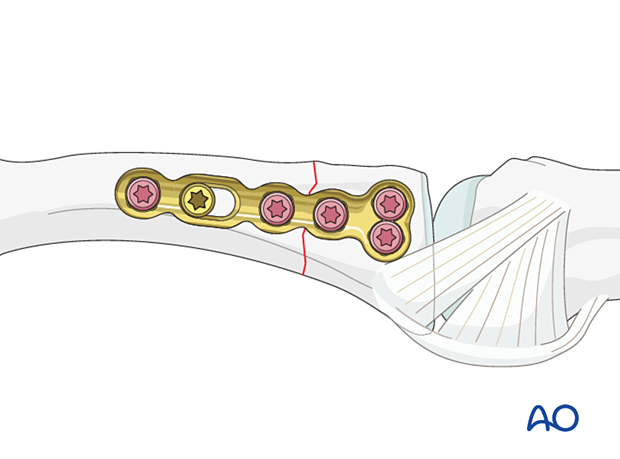
Plate selection
Two plate types are available for treatment of this fracture:
- 1.5 mm phalangeal base plate; lateral or dorsal
- 1.5 mm T-plate (adaption plate); dorsal
Select a plate according to fragment size, fracture geometry, and surgeon’s preference.
The plates are available as anatomical plates with variable-angle (VA) locking-head screws. This plate type has the advantage of sparing the soft tissue around the joints and allows insertion of two or three screws at variable angles into the articular block. The rounded plate edges avoid soft-tissue irritation and adhesion.
If an anatomical plate is not available, a conventional minicondylar plate may be used.
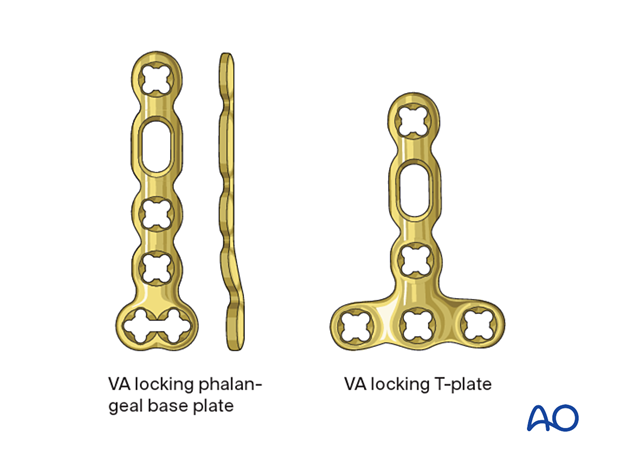
2. Patient preparation
Place the patient supine with the arm on a radiolucent hand table.

3. Approach
For this procedure, the following approach may be used:
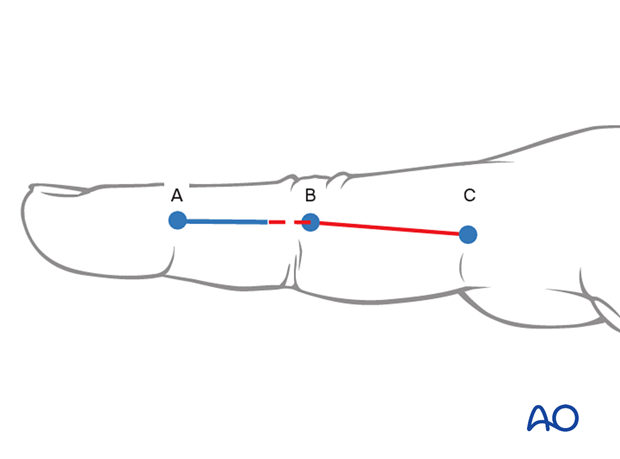
4. Reduction
Indirect reduction
Reduction can be achieved by traction and flexion of the metacarpophalangeal (MCP) joint exerted by the surgeon.
If the fracture appears stable after reduction, nonoperative treatment can be considered. Confirming reduction with an image intensifier is then essential.
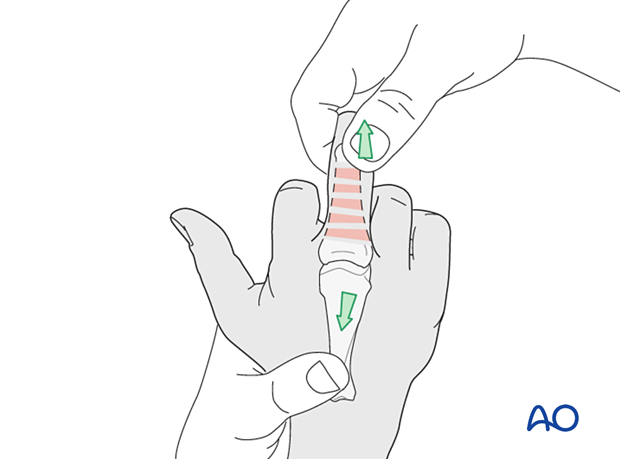
Direct reduction
Direct reduction is necessary when the fracture cannot be reduced by traction and flexion or is unstable because of surrounding soft-tissue lesions.
When indirect reduction is not possible, this is usually due to interposing parts of the extensor apparatus.
Use two pointed-reduction forceps for direct reduction.
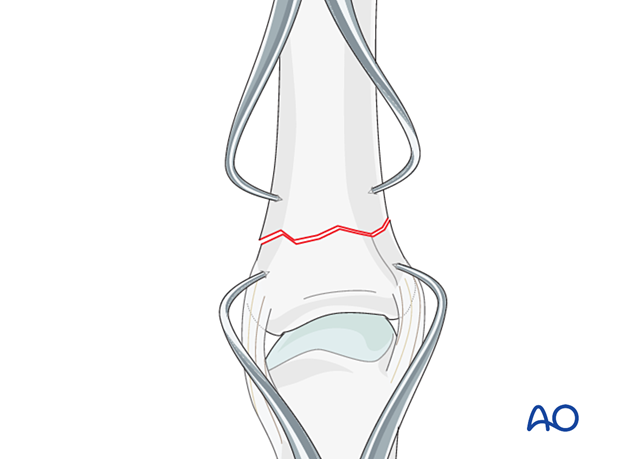
Preliminary fixation
Insert a K-wire for provisional fixation.
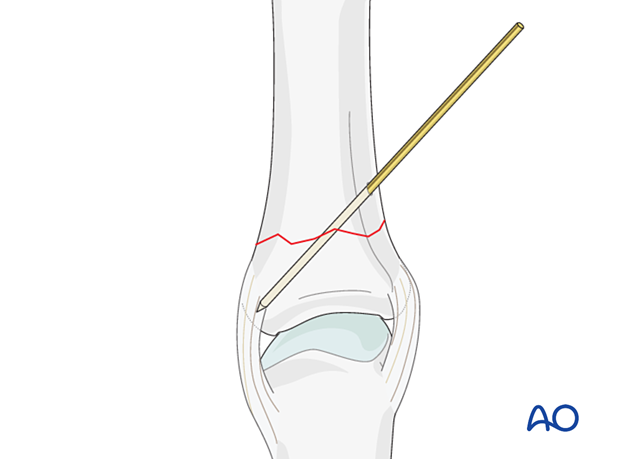
5. Checking alignment
Identifying malrotation
At this stage, it is advisable to check the alignment and rotational correction by moving the finger through a range of motion.
Rotational alignment can only be judged with flexed metacarpophalangeal (MCP) joints. The fingertips should all point to the scaphoid.
Malrotation may manifest by an overlap of the flexed finger over its neighbor. Subtle rotational malalignments can often be judged by a tilt of the leading edge of the fingernail when the fingers are viewed end-on.
If the patient is conscious and the regional anesthesia still allows active movement, the patient can be asked to extend and flex the finger.
Any malrotation is corrected by direct manipulation and later fixed.
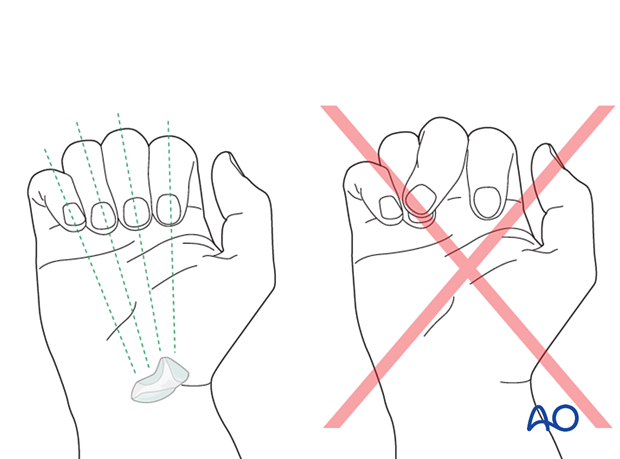
Using the tenodesis effect when under anesthesia
Under general anesthesia, the tenodesis effect is used, with the surgeon fully flexing the wrist to produce extension of the fingers and fully extending the wrist to cause flexion of the fingers.
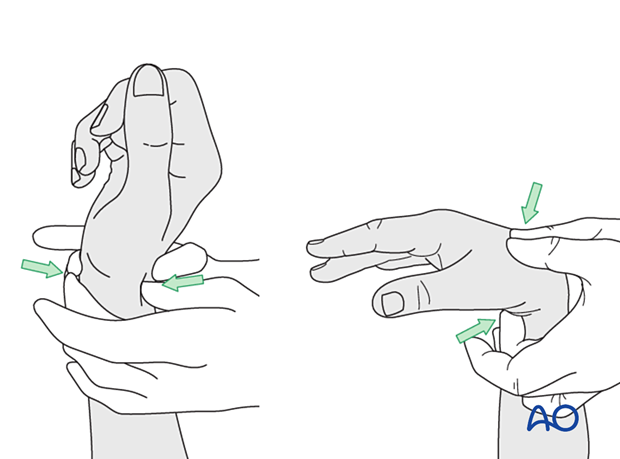
Alternatively, the surgeon can exert pressure against the muscle bellies of the proximal forearm to cause passive flexion of the fingers.
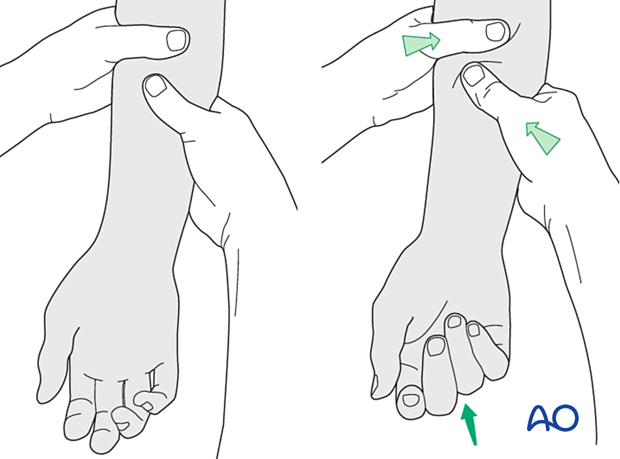
6. Plate fixation
The fixation of a transverse fracture with a lateral plate follows the principles of compression plating of transverse fractures.
Plate trimming
Adapt the plate length to fit the length of the proximal phalanx. Avoid sharp edges, which may be injurious to the tendons. There should be at least 3 plate holes distal to the fracture available for fixation in the diaphysis. At least two screws need to be inserted into the diaphysis.
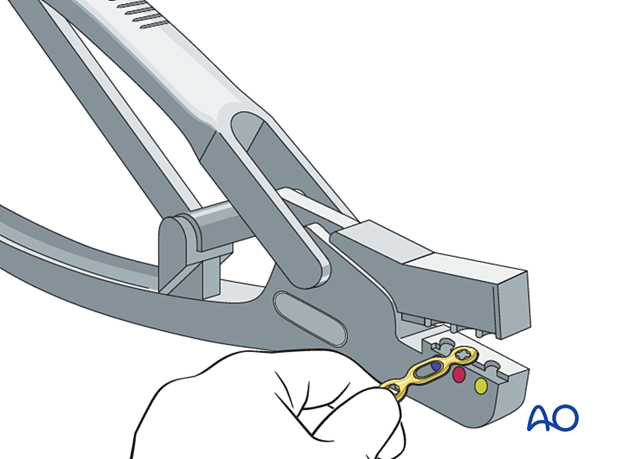
Plate positioning
Place the plate slightly dorsal to the midaxial line of the bone, allowing at least two screws in the proximal fragment.
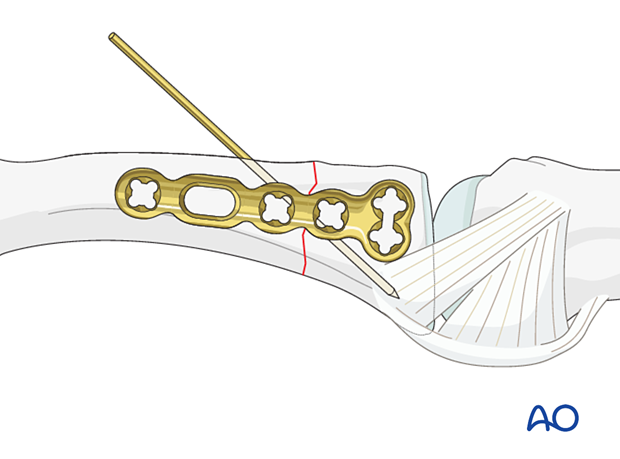
Keep the plate in place with the atraumatic forceps.
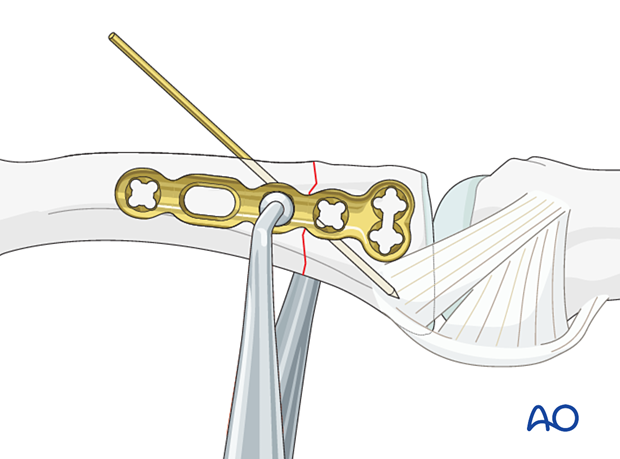
Screw insertion
Insert at least two VA locking head screws in the articular block.
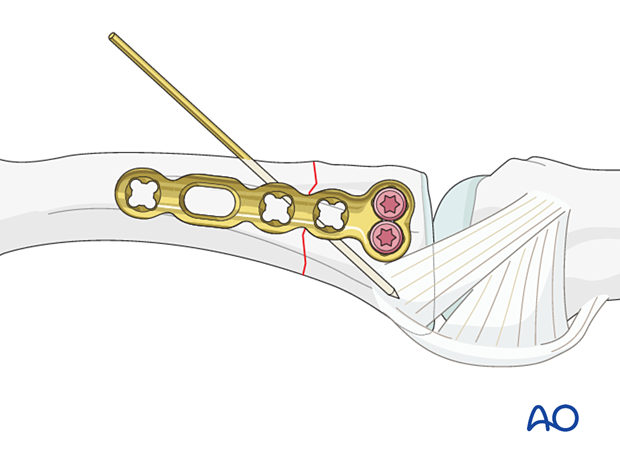
Insert the next screw in compression mode in the oblong hole.
Check the plate position with an image intensifier and adjust it if necessary.
Compression may also be achieved extrinsically with reduction forceps and then held with a locking screw.
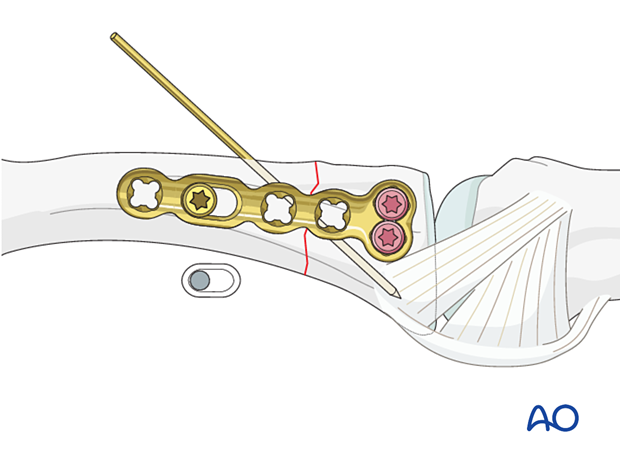
Insert further screws in the shaft and proximal end.
Cover the plate with periosteum to avoid adhesion between the tendon and the implant leading to limited finger movement.

7. Final assessment
Confirm fracture reduction and stability and implant position with an image intensifier.
8. Aftercare
Postoperative phases
The aftercare can be divided into four phases of healing:
- Inflammatory phase (week 1–3)
- Early repair phase (week 4–6)
- Late repair and early tissue remodeling phase (week 7–12)
- Remodeling and reintegration phase (week 13 onwards)
Full details on each phase can be found here.
Postoperative treatment
If there is swelling, the hand is supported with a dorsal splint for a week. This would allow for finger movement and help with pain and edema control. The arm should be actively elevated to help reduce the swelling.
The hand should be splinted in an intrinsic plus (Edinburgh) position:
- Neutral wrist position or up to 15° extension
- MCP joint in 90° flexion
- PIP joint in extension
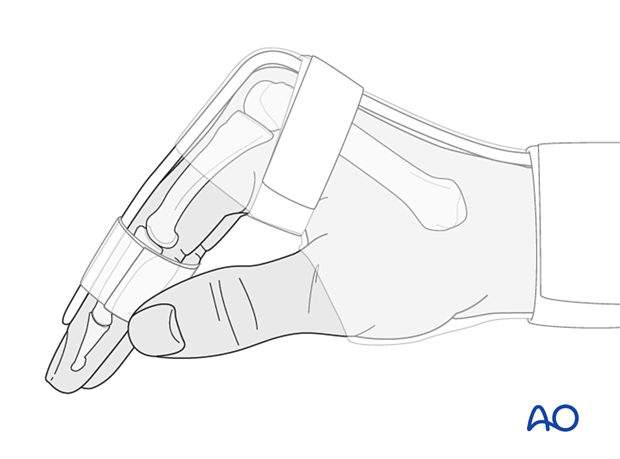
The reason for splinting the MCP joint in flexion is to maintain its collateral ligament at maximal length, avoiding scar contraction.
PIP joint extension in this position also maintains the length of the volar plate.
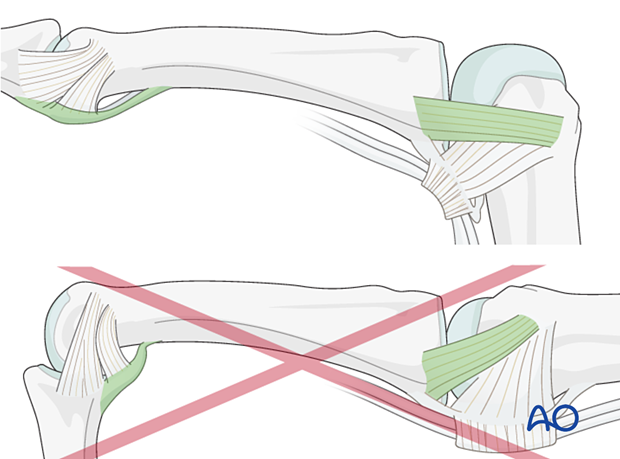
After subsided swelling, protect the digit with buddy strapping to a neighboring finger to neutralize lateral forces on the finger.
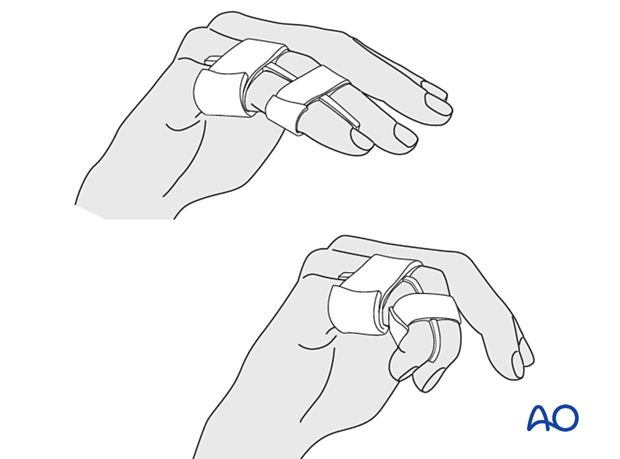
Functional exercises
To prevent joint stiffness, the patient should be instructed to begin active motion (flexion and extension) immediately after surgery.
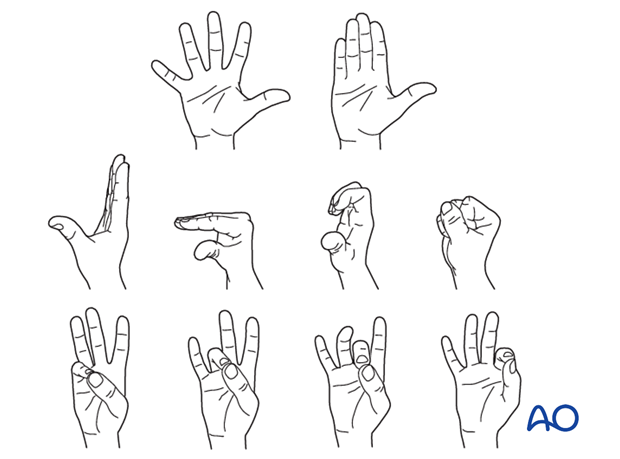
Follow-up
See the patient after 5 and 10 days of surgery.
Implant removal
The implants may need to be removed in cases of soft-tissue irritation.
In case of joint stiffness or tendon adhesion restricting finger movement, arthrolysis or tenolysis may become necessary. In these circumstances, the implants can be removed at the same time.













